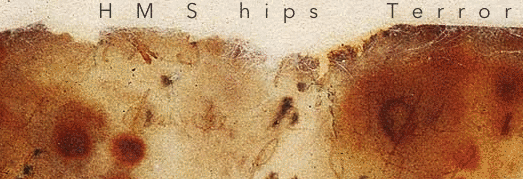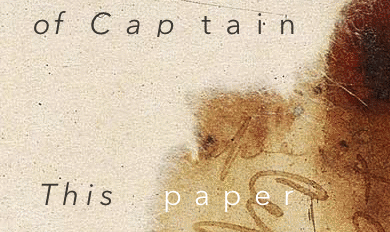By Logan Zachary. February 18, 2021.

A rare early photograph of the Victory Point Record, dated about 1859. (Click pic for full resolution.)
It is so early that we can see letters of words that have rotted away since the note’s discovery.

|
| Tasmanian Archives: Jack Thwaites Collection; NS1155/1/20 / © National Maritime Museum, Greenwich, London |
These letters are not new to us; they were carefully recorded at the time. They were used to infer additional words that – even then – were missing from the VPR’s damaged lower left corner.

|
| Illustrated London News facsimile of the Victory Point Record, 1 Oct 1859, p. 327 |
This newspaper facsimile shows how the lost fragments reconstructed additional words. With Cheyne’s photograph, we can see the original James Fitzjames handwriting with which the Victorian searchers completed these sentences.
* * *
I received this early photograph after requesting that the Tasmanian Archives digitize their Cheyne Stereographic Slides set, as part of a series on Cheyne that I’ve been writing. The Victory Point Record was #12 in Cheyne’s photography of the new McClintock relics from 1859.
At first I considered Cheyne’s VPR photograph to be of little interest, as Greenwich’s National Maritime Museum has published its own (modern, well-lit) photograph of the VPR.
Recently I did a closer comparison, seeing that Cheyne’s photograph shows fragments of the Victory Point Record that have since been lost.


“HMShips” has lost half of what had originally survived. The upper portion of the “B” in Erebus is rotted away.

|
| Tasmanian Archives: Jack Thwaites Collection; NS1155/1/20 / © National Maritime Museum, Greenwich, London |
In the corner, the “–tain” of Captain has completely vanished. This was part of Fitzjames’ first mention of Captain Crozier in the document, now as expedition leader: “…105 souls under the command of Captain FRM Crozier…”
Below it, the downstroke on the first letter of “paper” is gone. “This paper was found by Lt. Irving…”

|
| D2184, F6214 © National Maritime Museum, Greenwich, London |
Two little ‘chimneys’ near the damaged corner have gone missing. The right chimney is only visible on certain Cheyne #12 slides (such as Greenwich’s, above). But the left chimney is the important one.

|
| The 1859 Netherclift facsimile (courtesy Alison Freebairn) |
During a comparison of VPR facsimiles last year, I noticed that the 1859 Netherclift puts a fragment of handwriting underneath that left chimney – a curved line. No other facsimile records this. If accurate, the word in that position would be “April.”
And compared to all others, the 1859 Netherclift is extremely accurate. The Netherclift was the VPR facsimile included in the first edition of McClintock’s expedition book, The Voyage of the Fox (published in December 1859). It is possible that this curved line was only legible immediately after McClintock’s expedition returned to London. [Indeed, Netherclift’s own later 1869 facsimile omits this bit of curved handwriting.]
Was the handwriting lost when that ‘chimney’ piece broke off? Could it still be hanging on? I tried to see it in person at Greenwich, but the area is too dark. A conservator at Greenwich would have to use a light from beneath, or some other method, to determine it if it’s still there. [If it’s ever found and recorded, there is an easy handwriting comparison available: Fitzjames writes the word “April” again later in the same line.]

Aside from the missing handwriting, Cheyne’s VPR photograph also shows that the foxing/staining has increased since the document’s recovery. Des Voeux’s rank of “Mate” is just shy of unreadable today, whereas in 1859 it was cleaner than Gore’s “Lieut”.
* * *
Considering this Cheyne photograph, one conclusion to draw is that there is no single “canonical” Victory Point Record image. Facsimiles like the Netherclift make for easier reading, but they are still mere facsimiles. The modern Greenwich photograph is very sharp, but illegible in places due to stains – and now we can see that it has lost some original handwriting. The Cheyne photograph restores our view of that handwriting – but the more primitive photography renders the staining opaque, in addition to creating some apparently out-of-focus areas. Finally, the document in Greenwich itself (and many facsimiles) still requires the reader to know the words missing from the lower corner in order to read it properly. Anyone studying this single record therefore requires three versions on hand to see it from every angle.
When considering these missing fragments of handwriting, it’s a blessing how intact this paper is. McClintock had written in The Voyage of the Fox that the VPR was "much damaged by rust" and that "a very few more years would have rendered [it] wholly illegible." Mentally scissor off any quarter of the document – or delete a line of text – and imagine the contortions that would be done trying to understand, e.g., fragments of the section on “Sir James Ross’ pillar.” It’s a good practical exercise to prepare for what might be coming if only fragments of papers are recovered from Erebus and Terror.
The End.
– L.Z. February 18, 2021.
* * *
Appendix: Notes
1. The metadata embedded in Greenwich’s VPR image show the document to have been photographed on December 13th, 2005. At 2 o’clock in the afternoon.
2. The careful reader will notice that the word "April" is almost fully extant in the Illustrated London News facsimile – which predates at least the printing of the Netherclift facsimile by several months. This should be disregarded. While the ILN facsimile is useful for showing the inferred words, it is extremely inaccurate as compared to the original document.
3. I attempted to deal with the "3 images to study 1 record" problem a year ago by contributing a synthesized image on RtFE. This image showed the Greenwich VPR photograph overlaid with – when necessary – the clear Netherclift facsimile’s handwriting, in addition to using Fitzjames’ handwriting elsewhere to reconstruct the missing corner words. But that was all before I knew of this Cheyne photograph; another attempt is needed to synthesize all three together.
This is Part 4 in a series revolving around Cheyne’s relic photography.
- Part 1: The Missing Toy Sledge from Erebus
- Part 2: Cheyne’s Motion Pictures
- Part 3: Cheyne’s Relics
- Part 4: Lost Letters of the Victory Point Record
- Part 5: Where The Fox Docked
- Part 6: Who Was Photographed With The Fox?
- Part 7: Reversing the Chronometers at the Boat Place
- Part 8: A Stained London Pocketwatch
- Part 9: (forthcoming)
For a little more on the VPR, including speculation on other lost words, see older entries in Observations on the Victory Point Record (link).
– L.Z. February 18, 2021.

